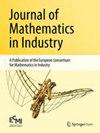固相熔化钢板火焰切割的建模与仿真
IF 1.7
Q3 MATHEMATICS, INTERDISCIPLINARY APPLICATIONS
引用次数: 8
摘要
本文的目标是详细描述一个准稳态模型,该模型可用于深入理解火焰切割过程中钢板的热量分布以及钢的固相和液相的变化。我们使用的3d模型类似于thi本文章由计算机程序翻译,如有差异,请以英文原文为准。
Modelling and simulation of flame cutting for steel plates with solid phases and melting
The goal of this work is to describe in detail a quasi-stationary state model which can be used to deeply understand the distribution of the heat in a steel plate and the changes in the solid phases of the steel and into liquid phase during the flame cutting process. We use a 3D-model similar to previous works from Thiébaud (J. Mater. Process. Technol. 214(2):304–310, 2014) and expand it to consider phases changes, in particular, austenite formation and melting of material. Experimental data is used to validate the model and study its capabilities. Parameters defining the shape of the volumetric heat source and the power density are calibrated to achieve good agreement with temperature measurements. Similarities and differences with other models from literature are discussed.
求助全文
通过发布文献求助,成功后即可免费获取论文全文。
去求助
来源期刊

Journal of Mathematics in Industry
MATHEMATICS, INTERDISCIPLINARY APPLICATIONS-
CiteScore
5.00
自引率
0.00%
发文量
12
审稿时长
13 weeks
 求助内容:
求助内容: 应助结果提醒方式:
应助结果提醒方式:


